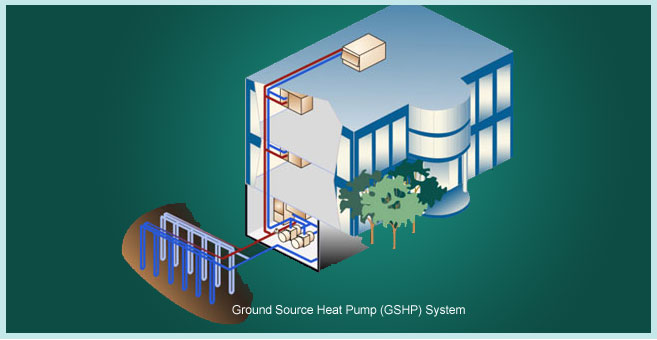GROUND SOURCE HEAT PUMP (GSHP) SYSTEM

GSHP-based central air conditioning system utilizes ground cold/heat sources for building heating and cooling purpose. This system makes use of the geothermal resources on the shallow surface of the earth to heat buildings by upgrading low-level ground heat energy via heat pump in winter and cool buildings by transfer internal heat to below grade via heat pump in summer.
Compared to other kind of energy, GSHP shows its advantages as:
- Renewable energy utilization: GSHP is an energy-conversion air conditioning system utilizing geothermal resources on the shallow surface of the earth (usually less than 400m deep) as the cold/heat source. The shallow surface of the earth is an enormous solar heat collector capable of collecting 47% solar energy (more than 500 times of annual energy consumption by human being). It is infinite, boundless low-level heat and a usable clean renewable energy.
- Economical energy efficiency technology: the soil temperature on the shallow surface of the earth is relatively stable all year round. It is higher than ambient temperature in winter and lower in summer. With such technology, the operation efficiency of GSHP is higher than traditional air conditioners.
- Apparent environmental effect: closed loop circulation without extracting underground water prevents pollution of underground water and surface depression. Operation of heat pumps is free from any pollution, combustion, smoke emission and wastes, so neither space for piling fuel wastes nor remote heat transmission is necessary.
- Low maintenance cost: underground heat exchange ensures 50-year system operation and is free from maintenance during operation and therefore saves maintenance cost.
- Non-influence on building appearance: no need for outdoor units reduces cooling tower capacity and imposes no influence on appearance of building façade. The openings for installing underground heat exchanger can be made at green spaces, roads or garages, by which the normal function will not be influenced.
Professional team of UPPC® carries out site survey and data collection to understand the thermal physical properties of soil and backfill materials, pattern of underground heat exchanger, and the number and distribution of pipe shafts; and analyze special situations of each project. By combination with the innovative GSHP ground heat exchange model in the optimized control system of UPPC®, the yearly attenuation of thermal storage property of soil is fully considered to realize optimized control of GSHP system.
Improve the performance of GSHP by setting chilled water temperature at user terminals in summer time. As for GSHP with auxiliary cooling devices, heat emission of ground source and that of cooling tower is balanced to sequence the operation priority and determine the setting value of control parameters so as to improve energy efficiency of compound GSHP system.
GSHP exchanges heat with soil via underground heat exchanger. Unbalanced heat absorption will deteriorate the thermal storage performance of soil. The optimized control system of UPPC® GSHP adjusts thermal balance of ground source heat pump system in summer and winter, and properly distributes winter heat absorption and summer heat emission of GSHP to maintain thermal balance of soil.
Optimized UPPC® control system of GSHP comprises variable frequency technology for pump on the ground source site to adjust the frequency of ground source pump and coordinates the influence on heat exchange efficiency, the energy consumption of heat pump and self-energy consumption of water pump on the ground source side arising out of decrease of circulating water flow rate on the ground source side so as to determine the flow rate of circulating water on the ground source side and further improve energy efficiency of GSHP system.
